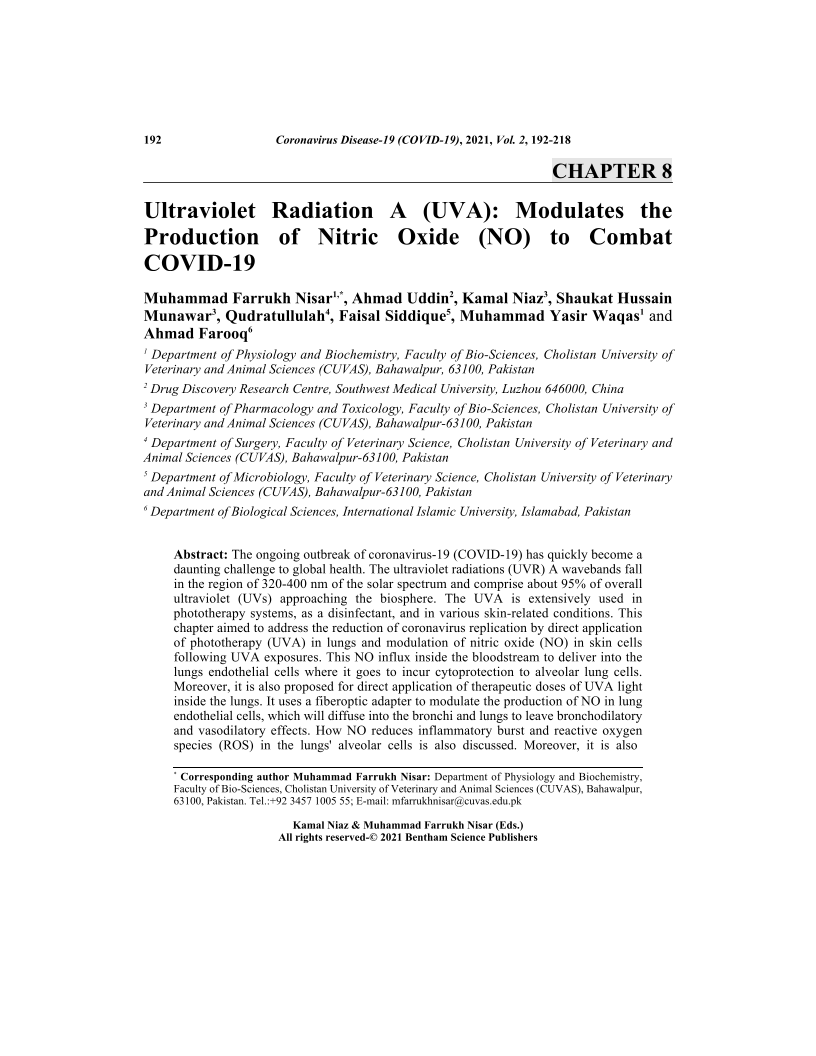Ultraviolet Radiation A (UVA): Modulates the Production of Nitric Oxide (NO) to Combat COVID-19

- Authors: Muhammad Farrukh Nisar1, Ahmad Uddin2, Kamal Niaz3, Shaukat Hussain Munawar4, Qudratullulah5, Faisal Siddique6, Muhammad Yasir Waqas7, Ahmad Farooq8
-
View Affiliations Hide Affiliations1 Department of Physiology and Biochemistry, Faculty of Bio Sciences, Cholistan University of Veterinary and Animal Sciences (CUVAS), Bahawalpur, 63100, Pakistan 2 Drug Discovery Research Centre, Southwest Medical University, Luzhou 646000, Pakistan 3 Department of Pharmacology and Toxicology, Faculty of Bio-Sciences, Cholistan University of Veterinary and Animal Sciences (CUVAS), Bahawalpur-63100, Pakistan 4 Department of Pharmacology and Toxicology, Faculty of Bio-Sciences, Cholistan University of Veterinary and Animal Sciences (CUVAS), Bahawalpur-63100, Pakistan 5 Department of Surgery, Faculty of Veterinary Science, Cholistan University of Veterinary and Animal Sciences (CUVAS), Bahawalpur-63100, Pakistan 6 Department of Microbiology, Faculty of Veterinary Science, Cholistan University of Veterinary and Animal Sciences (CUVAS), Bahawalpur-63100, Pakistan 7 Department of Physiology and Biochemistry, Faculty of Bio-Sciences, Cholistan University of Veterinary and Animal Sciences (CUVAS), Bahawalpur, 63100, Pakistan 8 Department of Biological Sciences, International Islamic University, Islamabad, Pakistan
- Source: Coronavirus Disease-19 (COVID-19): Different Models and Treatment Strategies , pp 192-218
- Publication Date: October 2021
- Language: English
Ultraviolet Radiation A (UVA): Modulates the Production of Nitric Oxide (NO) to Combat COVID-19, Page 1 of 1
< Previous page | Next page > /docserver/preview/fulltext/9781681089072/chapter-8-1.gif
The ongoing outbreak of coronavirus-19 (COVID-19) has quickly become a daunting challenge to global health. The ultraviolet radiations (UVR) A wavebands fall in the region of 320-400 nm of the solar spectrum and comprise about 95% of overall ultraviolet (UVs) approaching the biosphere. The UVA is extensively used in phototherapy systems, as a disinfectant, and in various skin-related conditions. This chapter aimed to address the reduction of coronavirus replication by direct application of phototherapy (UVA) in lungs and modulation of nitric oxide (NO) in skin cells following UVA exposures. This NO influx inside the bloodstream to deliver into the lungs endothelial cells where it goes to incur cytoprotection to alveolar lung cells. Moreover, it is also proposed for direct application of therapeutic doses of UVA light inside the lungs. It uses a fiberoptic adapter to modulate the production of NO in lung endothelial cells, which will diffuse into the bronchi and lungs to leave bronchodilatory and vasodilatory effects. How NO reduces inflammatory burst and reactive oxygen species (ROS) in the lungs' alveolar cells is also discussed. Moreover, it is also proposed that UVA radiation application should be limited to physiological doses and applied every 4-8 h, with at least 24 h of therapy before reassessment. The treating physician should determine discontinuation of this direct UVA treatment into the lungs following observation of the patient's condition and the safety and efficacy of the treatment. This study will highlight and emphasize the importance of utilizing UVA radiation to control this epidemic.
-
From This Site
/content/books/9781681089072.chapter-8dcterms_subject,pub_keyword-contentType:Journal -contentType:Figure -contentType:Table -contentType:SupplementaryData105

